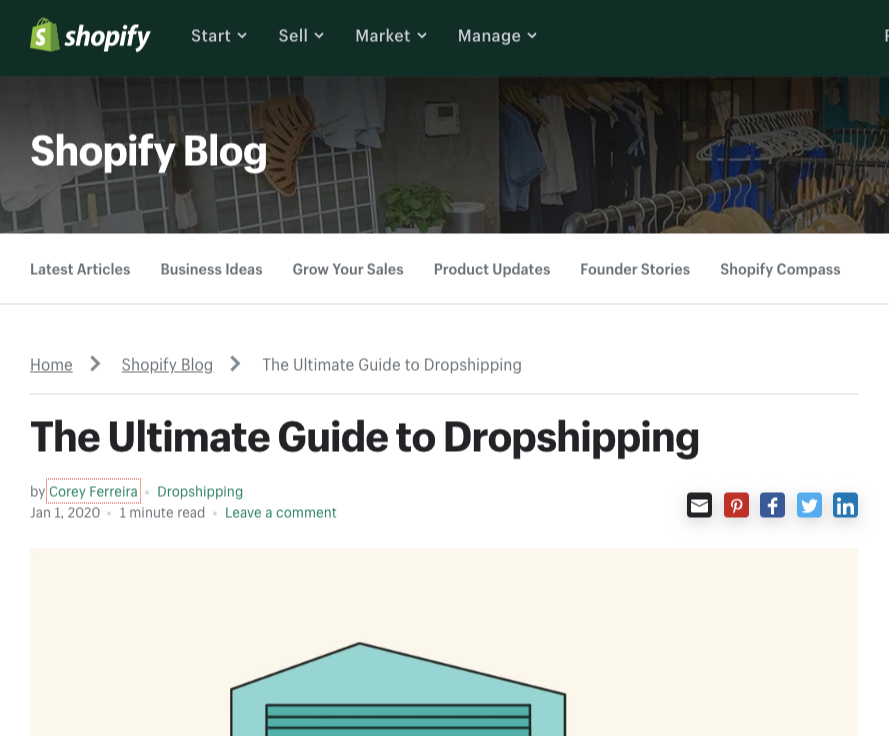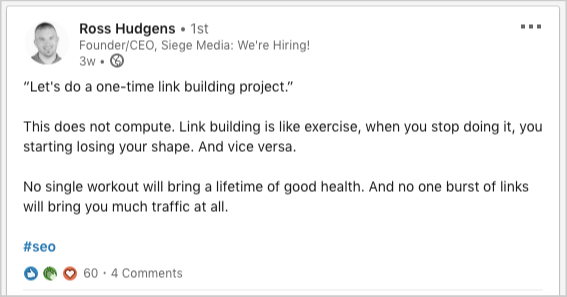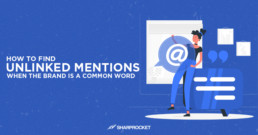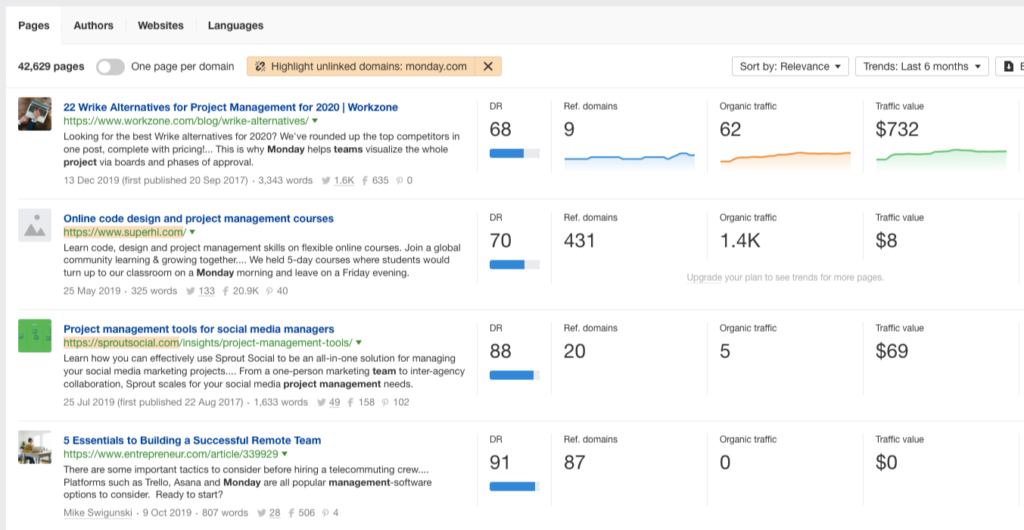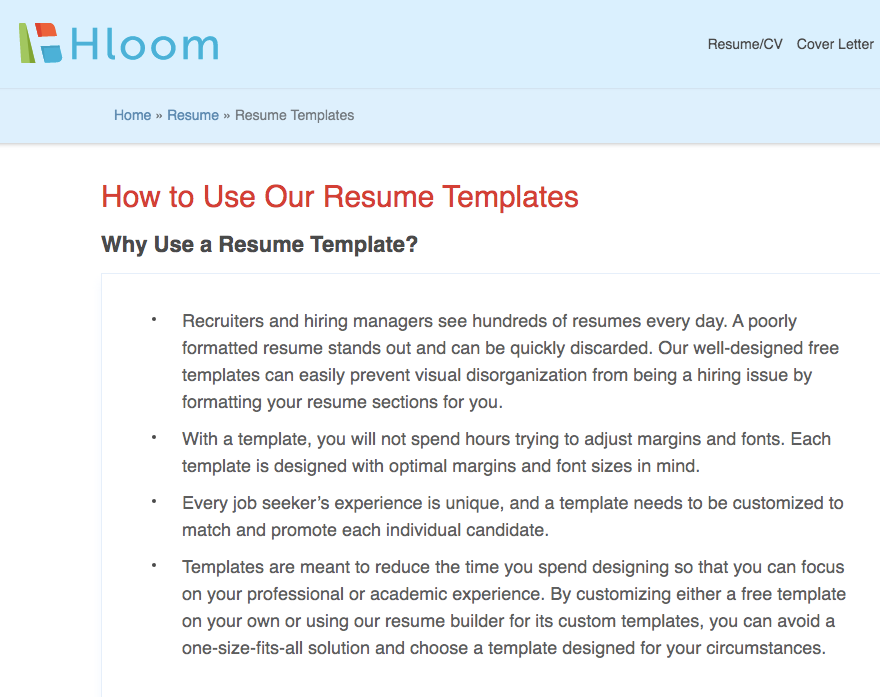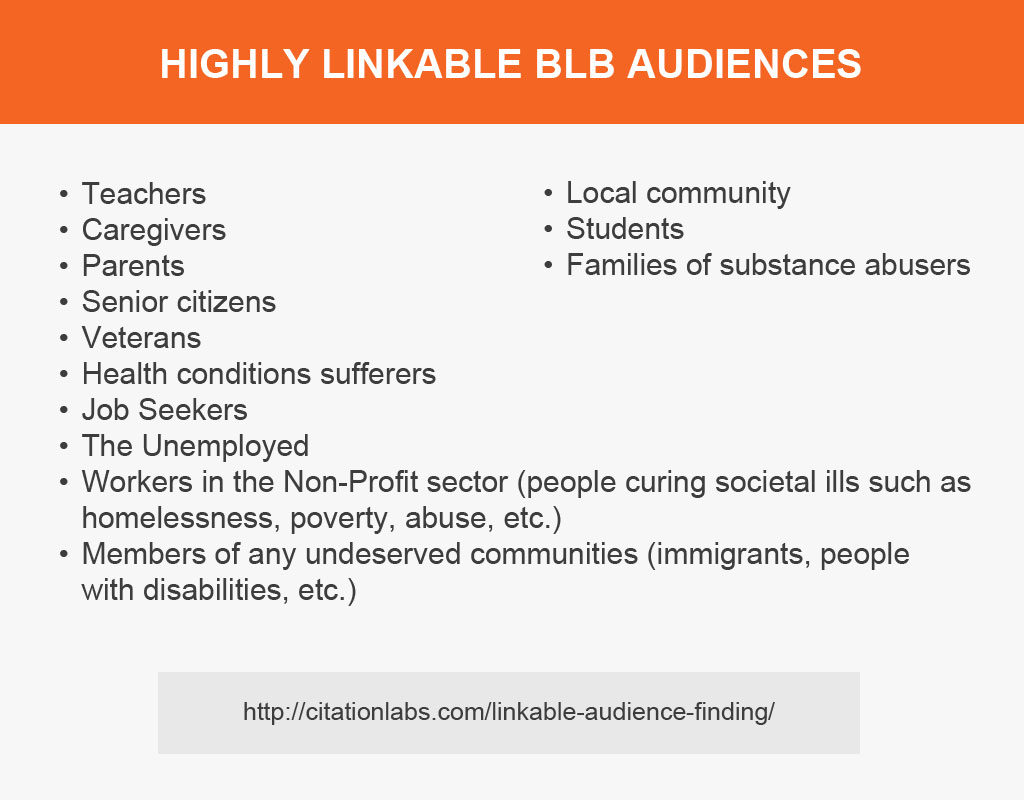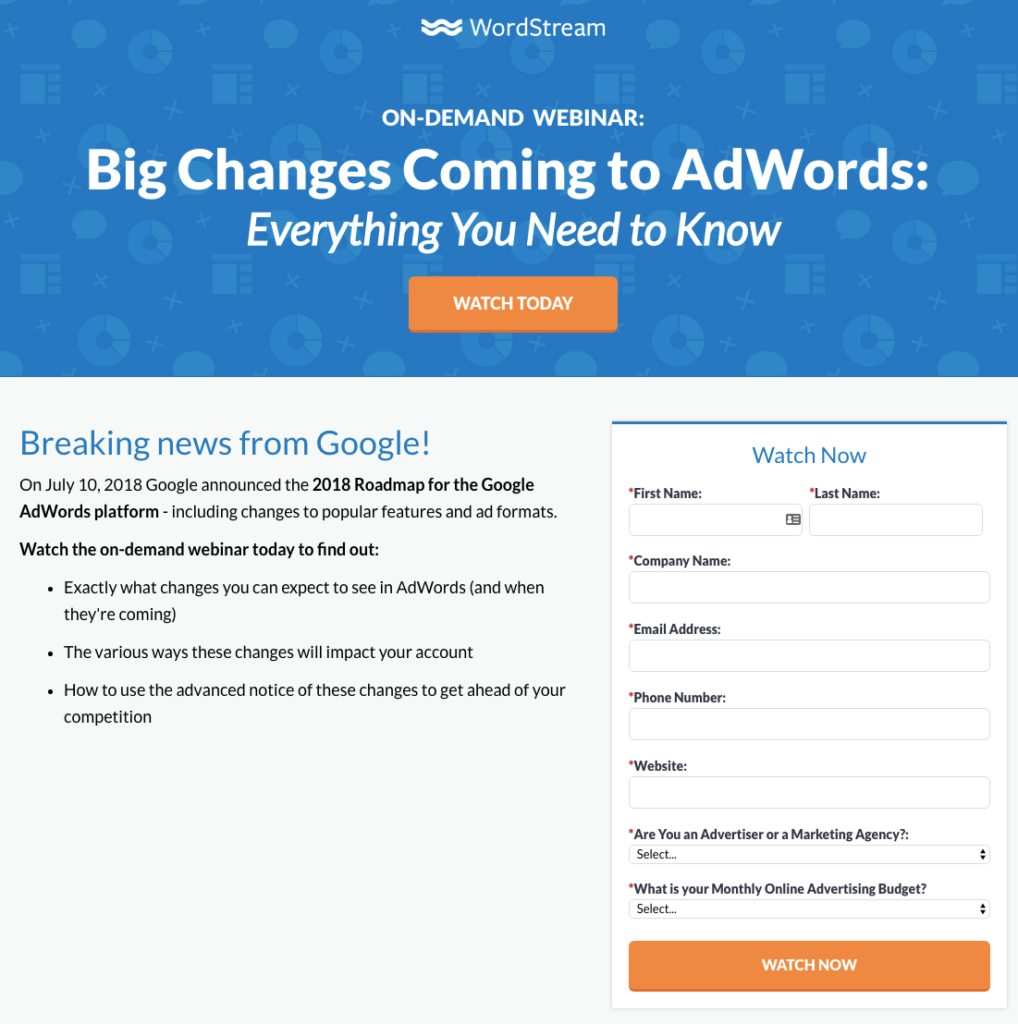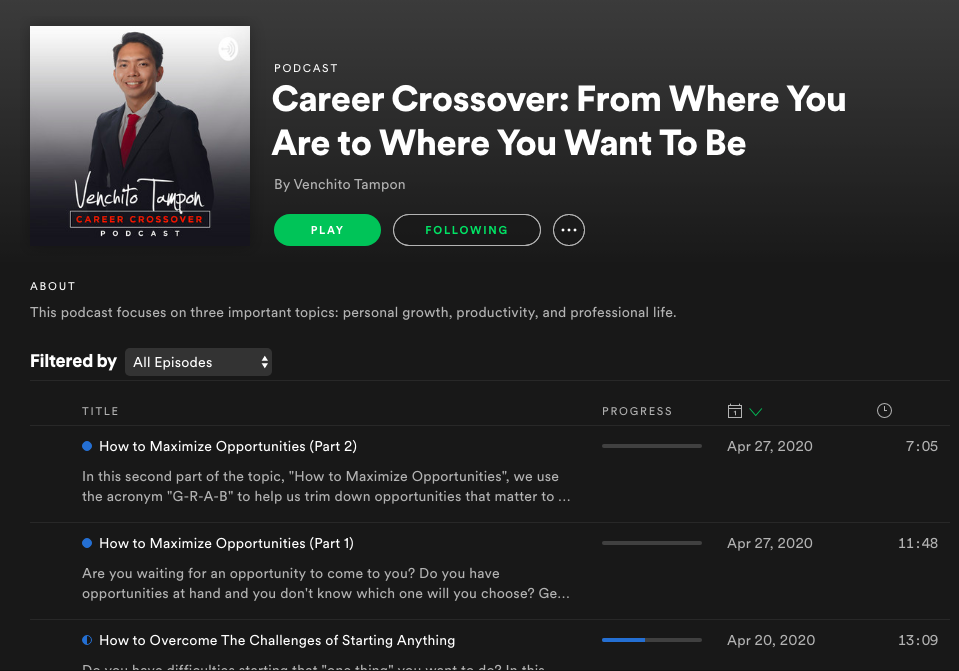Link Building Approaches For New Campaigns
Someone handed you over a website to start a link building campaign. Unsure of what to do, you do a Google search for how to start link building.
A bunch of articles pop up and give you tips. Almost all of which say the same topic.
Different approaches. Different link building strategies. Now the question, where will you start?
In today's article, I'll share with you tips on what to do when a client comes if you're working for an agency, or when you've just decided to build links for your new business site.
Understanding Resource Allocation and Scope of Work
Link building is a piece of the pie in the entire business project. It isn't a compartmentalized business activity.
Instead, it requires that you also look at other parts of SEO — technical side, for example, to gauge whether the client's site is ready for some link building engagements.
Essentially, you don't want to jump right in to link acquisition without the technical set up properly. It's not a rule, but it helps you see more results and developments from your link building, if your foundation is solid.
What is your scope of work?
Entering into a new link building campaign, you have to know the extent of your work. Are you just working to build links to specific pages or you can get links to different pages of the site?
This is true for big brands that have solid content assets and are now hiring link builders or agencies to come up with efforts for content promotion.
The scope of work for most enterprise link building campaigns are geared towards specific pages they're looking to rank for or have had positive secondary efforts on their conversions (mostly top of the funnel or middle-of-the-funnel driving pages).
If you have a very targeted link building campaign (either for 1 big content asset), you have the advantage of gaining and allocating your resources effectively.
One-time off project or long-term campaign?
As an agency that provides link building services to SEO agencies, we get clients looking for a one-time off project. It's understandable they've had a tight budget, but it is more advantageous that they take a long-term mindset in link development.
Don't just take my word, see how Ross Hudgens point this out.
What are your available resources?
Link building requires a team. If you think you can be a solo link builder for life, you can, but it would consume more resources than you'd have otherwise expected.
Depending on the size of your brand and your allocated marketing budget for search, you must have a good rundown of your resources. This includes your manpower — content writers, web designers/developers, outreach specialists/link prospectors — all are working together to attract and manually build links to pages.
If you're a link building agency, you'd want to know if the brand has partnered up with other link dev agencies. You would want to get an idea of the types of links they're focusing on and their targeted pages for links.
Starting with Content Inventory
When approaching a new link building campaign, it is vital to have a good content audit.
Not all new link building campaigns mean that there isn't any content piece created in the past. It would have been a new project for you, but there are certain solid content pieces that have been published before.
Content audit of the site
So start looking for underpromoted content assets on your website, but has the potential to earn and gain new inbound links today. You can use Ahrefs to find pages that have gained a considerable amount of links (a few .edu links here and there), yet wasn't pushed enough for more acquisition.
Reverse engineer competitors' content
Knowing how your competitors generate content ideas and do outreach campaigns (even in this new normal season) can give you insights to forge your link development campaigns.
One, in particular, you have to look at is if they've gotten high-level domain links such as.edu links.
Using any link analysis tools like Ahrefs, you can quickly check if they've launched a specific program that attracts middle schooler pages or local colleges to link to them naturally.
The type of content and its unique value proposition matters how they've performed well in link acquisition.
Another insight to look at is the ability of the brand to get recurring links from the same domains. In Ahrefs, there is an option to filter and see domains with its different pages linking to the brand.
The discovery shows the perceivable value of the site or a specific content — turning it into a link bait authority site.
Discovering Targeted Link Building Tactics
New campaigns will unpack link building tactics suited for the brand, given its industry, available resources, and past histories of link dev campaigns.
This makes link building fun and exciting, as you'll have to strategize a customized campaign for the website.
We've mentioned earlier deciphering the link strategies of competitors by looking at how they've gotten links in the past.
Another thing you have to consider is the range of domain level/authority of sites linking to them.
For example, in a tight niche, your competitors may only be getting links from DA10 to DA40 sites. Does that mean they're low-level link builders? Of course not, the industry may only have a few niche blogs to reach out, but getting links from these content creators are likely to impact the site's performance — given the topical relevance of those linking domains.
Having a good grasp of authority levels of linking websites will help you set a benchmark of domain levels for your new link building campaign.
idiosyncrasies of Tactics
When embarking on a new link dev campaign, here are certain unusual activities associated with common link building tactics we know of today.
A few examples are:
- Finding unlinked mentions when the brand is not a common word (unlinked brand mentions)
- Using branded email addresses for broken link building outreach (broken link building)
Elements that are only identified once you start a new campaign must be well documented to be able to turn them into a written process. This gives you the advantage of scaling small activities that could have a significant impact on your link building performance.
Suitable Content-driven Tips
When you have the bandwidth to try and test new content-driven techniques for your new campaign, don't hesitate to do so.
For example, you can launch a data-driven campaign to attract any national or international press — debunking the myth that only big brands can execute this.
With an artistic approach to creation, adding visual graphic designs, and research-backed content combined with highly custom pitching to publishers, you can get initial results other older established competitors can be hard to replicate.
Focus On What Matters
You can be quick to implementing results right off the bat. It's good to implement some processes you've managed to document for your past link building campaigns. But it is still better to customize campaigns for specific industries based on their context, objectives, and resources.
Knowing what truly matters for the brand helps in launching your new link building campaign.
How to Use Influence to Build More Links
A person with influence gets more opportunities than someone without. It's a reality most content marketers must embrace as they try to build content authority and influence through content marketing and link building.
Knowing how to use your sphere of influence has its given advantage in link acquisition. You earn hard-to-replicate links, repeated links from the same trusted domain or website, and even increase the exposure of your top or middle of the funnel content assets.
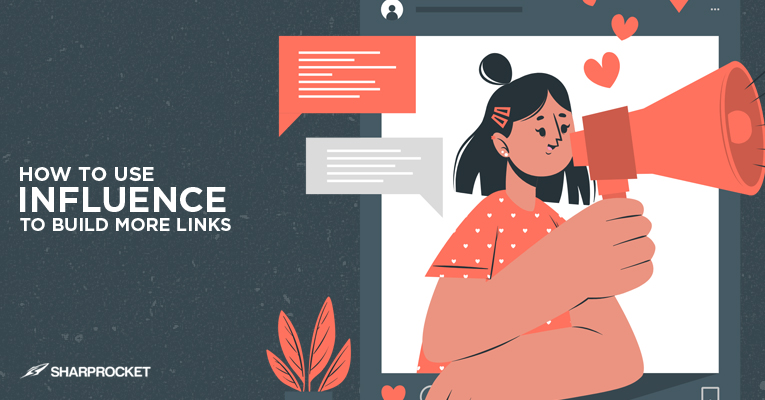
In this post, we'll cover tips on how you can use a sphere of influence to build more links to your website.
How to Use Sphere of Influence to Build More Links
1. Use seed planting strategy
A subtle approach in building your influence works pretty well in establishing trust without the need to invest a huge amount of resources — whether that's financial or time-intensive resources.
The key is to look for groups of people to whom you'll be adding value on a regular basis.
You're not looking for a massive group of audience, but a small targeted group who has the potential to amplify your brand content assets.
Discover your target group of amplifiers. You can check out this latest guide by Rand Fishkin to learn how to discover small invite-only amplifier groups.
You can also create your own list by finding small to medium-sized blogs in your niche using Buzzsumo.
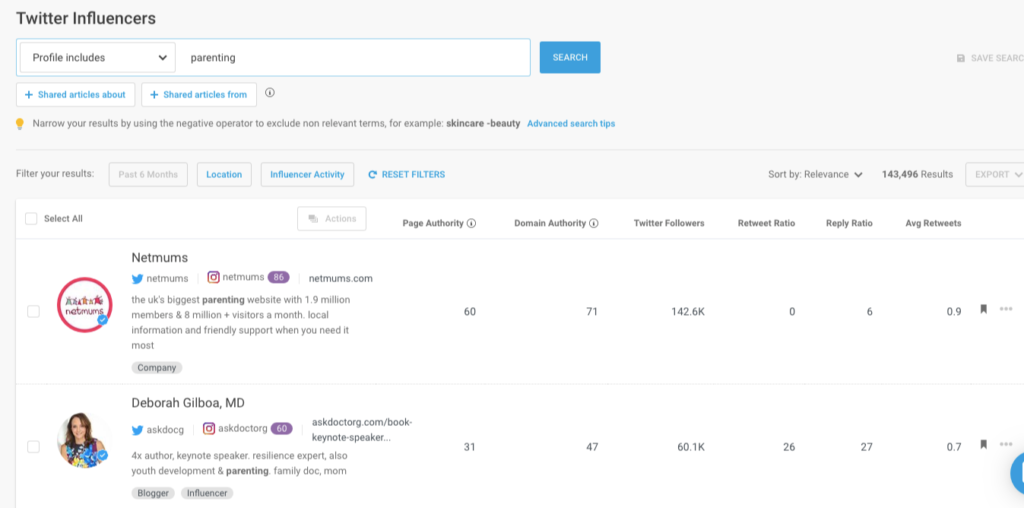
It is best to get radar of their latest posts by subscribing to their email newsletters or blog RSS feeds. This would get you notified of their new posts.
This is where the seed planting approach takes time. As soon as their new posts are published, be the first to comment.
Always add value to the conversation, perhaps ask a question. Don't just add any link to your content in your comment, unless it's relevant to the content you're commenting on.
In most cases, you use your name as anchor text to a link of your website — a standard approach on blog platforms.
Another seed planting technique is to share the latest content of your target content amplifiers. Get on their latest tweets and only share if it's relevant to your brand. Otherwise, you may come off as robotic and automated in sharing their stuff.
2. Engage in channel-specific groups
Besides creating your small list of content amplifiers that you'll engage in for further connections, you may also find specific channels where your target customers or content audiences engage in.
Here are some channel-specific groups you can consider:
- private Facebook groups
- private Slack groups
- Linkedin groups
- industry-specific websites (Growth Hackers)
- niche-relevant forums (Traffic Think Tank)
- private Skype conversations (invites only)
While not all of these you can't penetrate quickly, if you can find a few private groups where you can invest heavily in conversations, those are gems with a high return on investments.
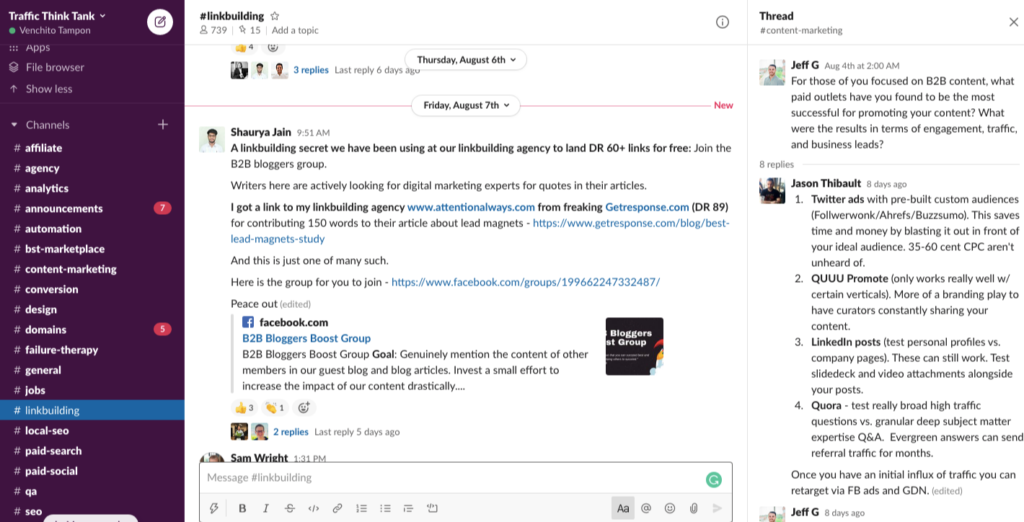
Getting into channel-specific groups has other content marketing benefits besides getting organic links. These benefits include:
- Generate new content ideas that are timely for the current business season
- Develop outreach strategies in the new normal based on engagement patterns to increase response and conversion rates
- Add more leads in your sales funnel through interested customers or clients of your services (driven by their perceived value on your engagement)
If you can look for channel-specific groups, you can engage better with your audience in a more personal, relatable approach. Thus, helping you build your brand and earn authority links.
3. Leverage LinkedIn as a subtle connector tool
LinkedIn shouldn't be a platform to spam people with straight right hook offerings (products/services).
There is a way to build relationships the right way, and at the same do link building without the need to annoy people with insensitive, non-personable messages.
Start optimizing your profile. The key is not just to introduce yourself in one message with lengthy profile credentials.
If you can provide enough details and descriptions in your profile about what you do for a living, you'll have better chances of getting more profile views. This can lead to more opportunities for connections and natural links in the process.
In addition, create a content plan for a month and have it scheduled to post for the best times every week.
You may opt to follow your existing content calendar or have a separate strategy just for LinkedIn posting.
By promoting your content assets natively on the platform, you'll have better chances of engagements, and an increase in organic reach.
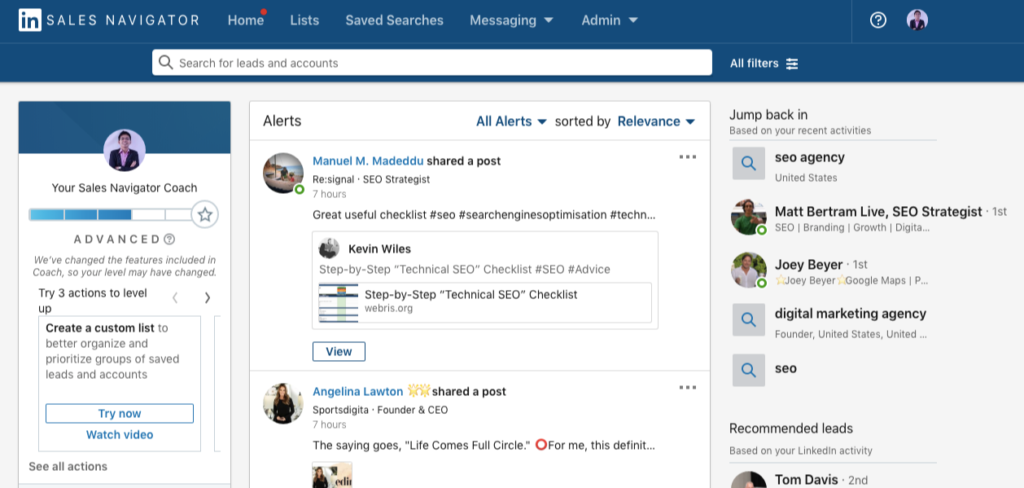
It is best to use the Linkedin premium account, particularly Sales Linkedin Navigator to maximize sending off invitations to target people. This gives you more capacity to add more like-minded influencers in your circles.
Enterprise sites can leverage Linkedin as a way to personalize their approach in connecting with their potential customers — strengthening their brands and acquiring new enterprise links.
4. Maximize attraction marketing
Influence has its advantage to attract high quality backlinks.
With the idea of marketing flywheel, you create more visibility by developing content resources that appeal to your target audience.
With organic and manual link building and content promotion, you reap your initial benefits of links, social shares, and other engagement signals. This gives you the opportunity to get more flywheel effect for your content.
Here are some ways to apply attraction marketing:
- Produce lead magnets such as checklists, top lists, and coupons — to capture email addresses, which would have an increased possibility of visibility for your future content assets.
- Develop comprehensive evergreen pages on your site that match your audience's needs (may it be a linkable audience you've chosen or a target group of influencers).
- Create timely content to attract new content consumers to your site. You can check out this guide on content marketing strategies during coronavirus.
Be A Value-Adding Influencer
Influence has its responsibility of putting people first. With this kind of mindset, you enable yourself to become a forceable brand that engages people with value-adding content assets.
How to Find Unlinked Mentions When the Brand is a Common Word
Link reclamation is a common link building technique for marketers today.
The idea is very simple: you get all those publishers or content creators who've mentioned your brand or your content but haven't linked to your site.
Then you reach out to them and ask to give you the links you deserve.
Oftentimes you gain a higher link placement rate than other link building techniques such as broken link building and guest blogging.
This is because there's already a brand connection between you and the publishers as well as an intended reason to link to you in the first place (they've used your content).
Here at SharpRocket, we've covered the entire process of this strategy in our link reclamation guide.
Like any other link building techniques, there are loopholes you have to consider by looking at methodologies that'll be effective to solve those particular problems.
In this post, we'll cover one common challenge link builders face when executing the link reclamation technique.
That challenge is finding unlinked mentions when the brand is a common word.
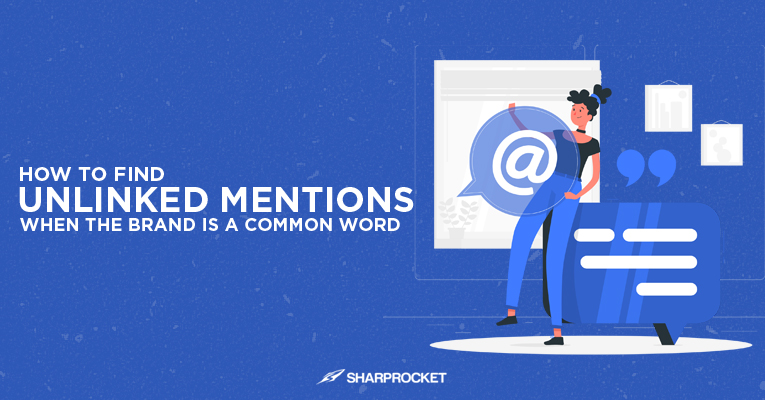
It's easy to spot pages that mentioned your brand if you have a unique brand name — i.e. Nike, Spotify, or Shopify.
There may be misspellings or typos as to how publishers may have mentioned your brand name on their posts — such in the case with Spotify or Shopify.
What is difficult to surface with are brand names with common words like Monday, or Apple. Monday is a project management software but is also referring to day itself. Apple as a technology company, while referring to a fruit.
As you go search for pages that mentioned your brand, you're likely to see different results. What do you do to sift through these results to only find relevant outreach prospects?
On Link Prospecting Phrases
Regardless of the tools, you'll be using for link reclamation prospecting, you need to have a list of words that should be associated with your brand.
In particular, these are your product types, product or service descriptions, or that one or two word detail about your brand.
Let's take Monday as our example. Monday is a project management tool. So, obvious words likely to be associated with are: 'Monday project management' or 'Monday task management'.
If you're working as an agency and this is your first client, you get to have a better understanding of your initial meetings with them. Having a good grasp of what they are and their products or services offer to the market would give you a list of words that define their brand as a whole.
You may opt into some research on Google by typing their brand.
For instance, a Google search result for Monday gives you the site's meta title and meta description. These are keywords the brand is trying to rank for in search.
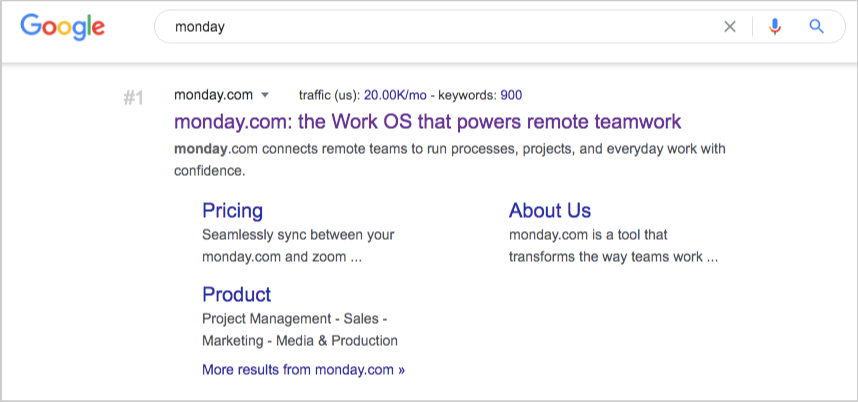
Add these words as your associated phrases to your link reclamation prospecting process:
- Monday remote
- Monday remote team
- Monday teamwork
- Monday remote teamwork
- Monday processes
- Monday enterprise
- Monday project
Another way to discover words you can add to your link reclamation prospecting list is by going through all of the existing mentions of your brand.
You can use Ahrefs Backlink Explorer to find pages already linked to your site. I prefer checking in pages where publishers usually linked to. These include your site's homepage and landing pages (e.g. product pages).
Sift through the pages and identify anchor texts publishers used to link to your webpages. There will be variations of anchor texts — long-tail description words and co-cited way of referring to your brand.
Add these newly discovered phrases (used as anchor texts) to your current link reclamation prospecting list.
Tools to Find Unlinked Mentions When the Brand is a Common Word
Link building requires some tools to surface brand mentions. Here are some tools you can use to find unlinked brand mentions.
1. Ahrefs Content Explorer
One of the tools that can help you with the link reclamation prospecting process is Ahrefs' CE.
There are a lot of advanced search operators in CE. If you're looking to return all pages that mention "Monday" AND either remote, team, process, project, management. You simply use "OR" to associated phrases.
So, the final advanced search query would be this: "Monday" AND ("project management" OR "remote team").

If your brand is a very common word, make sure you choose phrases rather than single words to return pages closest to what you are looking for.
Another strong tip is to exclude terms that refer to other topics not related to what your brand is about. For Apple, that might be "recipe", "pie", "cake", or "fruit" to exclude pages about the fruit term.
Be mindful that this may be tricky for some brands. In our example, "Monday" project management tool, if you exclude terms such as "day", "week", "month" or any calendar terms, you might end up excluding pages that mentioned both "day" and "project management" (which is about your brand) in the search results.
Hence, use exclusions if it makes sense to your brand.
Kindly click highlight unlinked domains and add the domain of your site. The websites of publishers that have never linked to you before will be highlighted, which means that the brand mentions those pages are unlinked.
2. Web mention tools
In link reclamation, you can't get away from using web mention tools. These are web products specifically designed to find pages of your unlinked mentions.
Examples of these are Ahrefs' Alerts feature, BrandMentions, and Google Alerts.
The same strategy with your search query inputs can be applied to web mention tools.
You can use any of the following search queries as your alert inputs.
Again, in our example today, you can have these queries:
- Monday remote work
- Monday remote team
- Monday teamwork
- Monday remote teamwork
- Monday processes
- Monday enterprise
- Monday project management tool
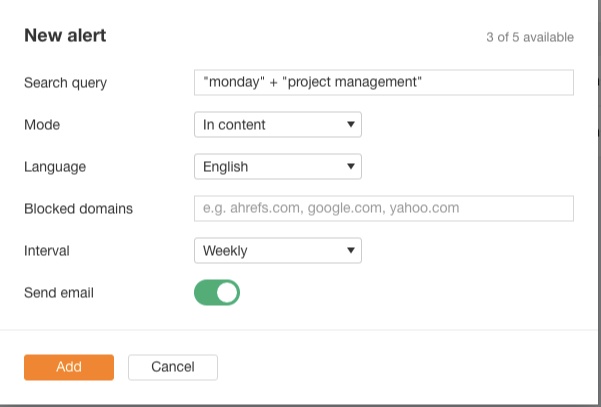
Exclusion and inclusion filters are also available in mention tools (AND, OR, —). Use them to your advantage to filter out irrelevant pages of your unlinked mentions.
Link Reclamation Made Simple
The most difficult challenge in link reclamation is sifted through results from your methods of link prospecting — manual and/or with the use of web mention tools.
If you're an agency, you get to master this strategy over time, as you can unpack ways to figure out how to discover unlinked mentions when your clients' brands are not common words.
Do you have any other tips to prospect for unlinked brand mentions? Let me know in the comment section below.
Do Enterprise Sites Need to Build Links?
Enterprise link building is a different landscape. It requires a need for planning and knowing what expected results you want from a link acquisition campaign.
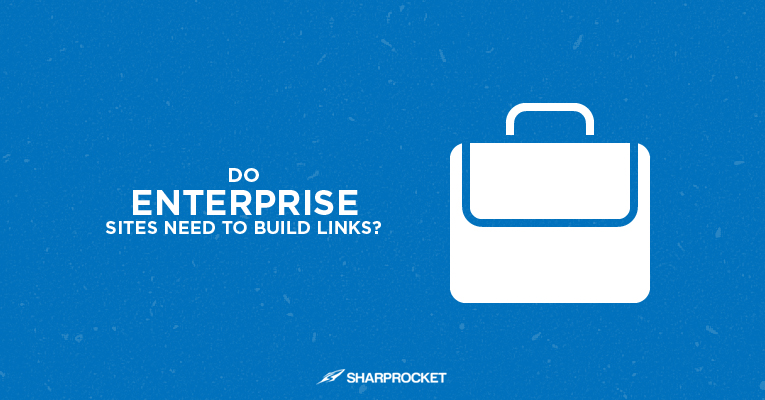
In today's post, we'll cover the need to build links for enterprise sites and understand what types of backlinks that will bring high brand value to them.
Do Enterprise Sites Need to Build Links?
The quick answer is yes.
Essentially, big enterprise sites are getting organic links, even without the manual link building campaigns.
Given their high-level top of the funnel and mid of the funnel content pieces, enterprise brands earn various types of links that bring more backlink growth than most small to medium business sites get.
However, most enterprise brands are not just waiting for links to come, but rather are more active in pursuing links. This is what we want to dig deeper a little bit — as to what types of links enterprises should be building for their sites.
Considerations When Building Links for Enterprise Sites
Since we are working with enterprise brands, we know what they're usually after in a link building campaign and what they do get out of it.
For many SEO and link building agencies, they know that once these enterprises' director of marketing or director of SEO reached out to them, these people know what to actually look for.
Though some may take some serious study and may need to be educated on why SEO matters to them, most enterprise clients who reached out have a good understanding of their needs.
Targeted Types of Pages
To be more effective in an enterprise link building campaign, one has to know the types of pages he/she should start prioritizing from the very start.
Generally, the focus of driving links are into core product pages — these are product pages that convert so well from sales and leads standpoint, but maybe struggling to get a ton of links.
To find viability for links, enterprise SEO teams will have supporting content guides internally linking to these product pages. These supporting pages will be used now as the value proposition to garner blog links or editorial links straight to them.
Another strategy is to add more informational elements (we call it as citable elements) to landing pages, such as product pages. By doing so, you get to serve a specific group of linkable audience and thus increase the likelihood of getting high authority links.
There is no successful link building campaign that will spend lots of money on random links. Enterprise sites have targeted pages they consider as part of their link building strategy.
Quality VS Quantity
Enterprise sites are aiming for both quantity and quality of links. They want to drive more, but highly relevant and authoritative links.
These authoritative links may have different benchmark metrics depending on which agency they're partnering with.
All backlink prospects should be relevant to the brand's content theme. It may be coming from industries, but sites that have engaged audiences enterprises cater to.
Besides relevance, metrics that I've found to get more buy-in from enterprise sites is the website's organic traffic, traffic cost, and brand value.
SEMRush helps you show websites' organic traffic and traffic cost. This gives you an idea if the website gets constant visibility from ranking pages on search — providing you with more referral visitors to your site.
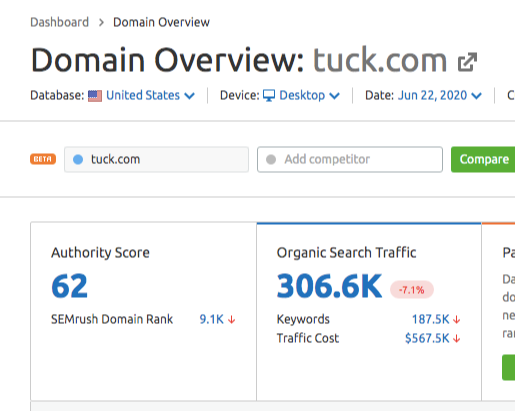
Brand value is also a key factor to consider in prospecting for relevant authoritative websites. This refers to how you see the potential linking site to give you better returns in branding impression as you go and get links from it.
Link Value Ratio
One of the big problems of many enterprise brands is not considering the link value ratio when executing a link acquisition campaign.
If you spend big budgets to build links to target pages that don't have any ranking and money potentials, you'll miss out on great opportunities that should've been invested in other content marketing initiatives.
Here is a great reference by Ross Hudgens that shows you how to compute for link value ratio.
Tactical Link Building for Enterprise Sites
A. Internal Linking
Oftentimes enterprise-level sites overlook their ability to leverage their internal linking capabilities. Their hundreds or thousands of pages can make wonders in terms of getting "quick wins" that they could have missed earlier if they proceeded right away to traditional link building.
Build internal links to funnel link equity to your most important pages. There are different ways to attack this one, and I recommend available resources below:
B. Link Reclamation
One of the best things to leverage in an enterprise site is its ability to capture the unlinked brand mentions from many sources.
A product worth mentioning on a blog post, a press release about your latest product feature, an interview about your executive about the changes happening in your company (or in your industry) are just some of the things you can monitor on a regular basis.
You can reach out to relevant publishers, content creators, or bloggers who mentioned any of your brand content (has your unlinked brand mentions) on their pages.
Get them to link to the most relevant page on your site.
If you're looking for a detailed process on this link building strategy, you can check out my guide on link reclamation.
C. Strategic Content Partnerships
As a link building company working with enterprise clients, what we've found to be a unique proposition for big brands is their pool of partners.
Those partners that they've built over the years can help set up collaborations much easier than usual.
Strengthen the brand more by associating it with well-liked entities. You can collaborate with other well-known content creators in producing a linkbait piece of content targeted to specific audiences.
Through content collaboration, you capture each of the content partner's followers and readers.
Another way to build high-value blog links is to create connections with authors who write for multiple websites about your industry.
These are authors who develop their personal brands to disseminate their messages in content by submitting guest posts to top-niche blogs.
So instead of the traditional guest blogging where you blast out distributed content to different blogs, you put your brand in a position where these guest authors come to you for links (link earning).
D. Reverse Outreach Campaigns
Reverse outreach is a strategy enterprise brands can take advantage of.
Instead of solely doing direct outreach to relevant publishers and content creators for external content distribution, they can leverage the power of linkbaiting — creating high-value pages to earn authority backlinks.
Since brands have strong domain power, they can rank pages for keywords in a short period of time.
One link building technique (earlier been mentioned) is the idea of inviting influential content creators to contribute and/or collaborate content for your blog.
The beauty of it is that you gain new expertly-crafted content pieces every now and then. You also acquire new links from these guest posts as they reference it (or externally link to it) from their other externally distributed content (guest posts).
Create more interesting content assets on your blog to attract links from relevant publishers as well as receive more targeted pitches from guest authors. Well then, you have your set of rules to select only practitioners who can write for your blog.
Having a reverse outreach strategy in place will keep you earning links consistently to your site.
Maximize Your Strengths As An Enterprise Site
There are many competitive advantages of running a link building campaign for an enterprise brand. With proper research and planning on highly performing linkable assets to inform future content creation decisions can help get low-hanging fruits of links.
Are you currently building links to enterprise site/s? Share any other link building tips in the comments below.
How Your Content Strategy Can Support Your Sales Team
Whether you call it content marketing, inbound marketing, or any other related term, the use of content to advance a business’s goals almost always falls under the umbrella of marketing. But don’t pigeon-hole content. By taking a broader view of content’s potential, you can identify plenty of ways it can be used to support your sales team as well.
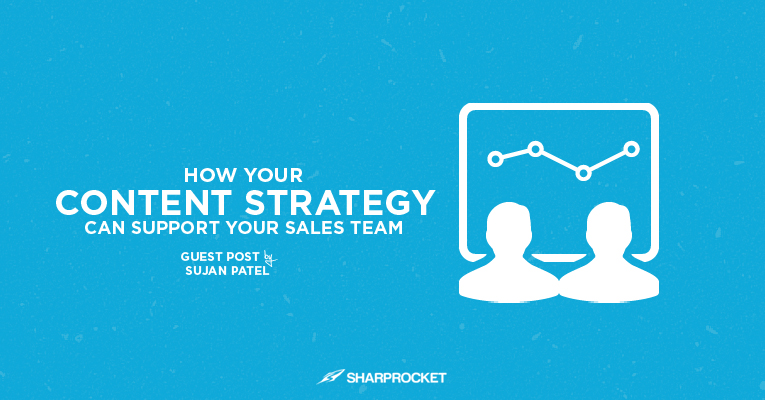
Marketing and sales don’t always play nice together. Marketing can execute brilliant, compelling content, but if it isn’t used by sales teams, it may not get the attention it needs to pull its weight from an ROI perspective.
Conversely, sales teams that plow forward without making use of the content assets available to them risk hamstringing their effectiveness, as more and more buyers prefer to engage with marketing content before ever connecting with a salesperson.
For your content strategy to support your sales team, you need to think about content through a broader lens. Here’s how to do it:
Understanding the Buyer Journey
If you’re going to use content to support elements of your sales cycle, you need to first understand the foundational concept of the buyer’s journey. Typically, this idea is presented in the shape of a funnel, split into different stages. Though exact funnel models vary, most include the following stages at a minimum:
- Awareness: A prospect becomes aware of a need they intend to fulfill through a purchase.
- Consideration: The prospect considers different potential solutions to their need; for instance, by evaluating your company against its competitors.
- Purchase: The prospect decides on a solution.
Some models include a post-purchase stage, while others break out the three above into more granular needs. Regardless of the specific approach, a few things hold true about funnel-based buyer journey models:
- The funnel shape is used to signify the natural attrition that occurs throughout the buyer journey. Not every prospect who becomes aware of your solution will become a customer.
- The amount of time prospects spend in the funnel depends on factors such as the significance of their need and the cost of your solution.
- Although prospects may not move through the funnel in a linear fashion, they must have their needs met at each stage before they become a customer.
Expanding on that last point, a prospect isn’t going to buy from you if they aren’t aware that they have a need to fulfill. Similarly, it’s unlikely that they’re going to buy from you without considering possible alternatives.
The good news is that, because we understand that prospects have questions that must be answered and need that must be fulfilled at each stage, we can transform these insights into content assets that can be used to support the sales team.
Here are a few strategies for doing so:
Creating Content Around Specific Product Features
In the Awareness and Consideration stages of the buyer’s journey, it’s common for prospects to have questions about specific product features.
Imagine that your company has identified a need for a new project management solution. You aren’t going to go out and sign up for the first Google result you come across. Instead, you’ll probably approach your decision in a more thoughtful way – such as by creating a list of must-have vs. nice-to-have features to guide your search.
Now, let’s assume that one of your team’s must-have features is integration with your existing CRM. Would you be more impressed by a salesperson who couldn’t give you a clear answer on whether or not their project management system integrates with your specific CRM? Or by one that can immediately send over one-pager listing popular integration, along with links to complete instructions for setting each one up?
As an example, take 17hats, a business management system for solopreneurs. The company’s help section features an extensive list of integration tutorials, including the instructions below for its Quickbooks Online integration:
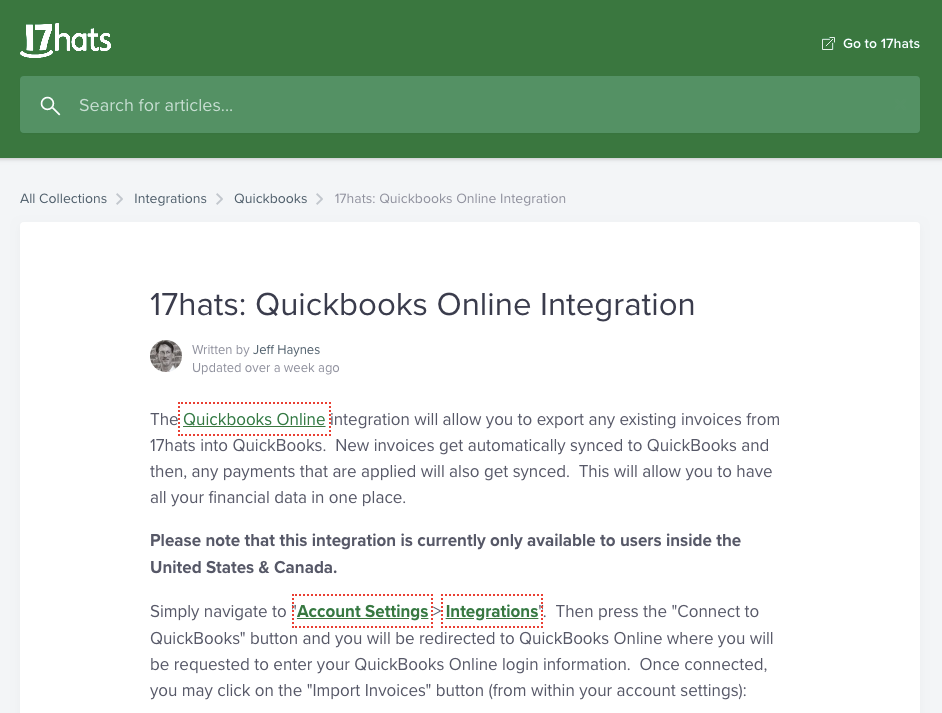
There are several things you’ll want to keep in mind when creating content around specific features:
- Not all buyers will be interested in the same features. Work with your company’s sales team to identify which features the prospects they talk to are most interested in so that you can prioritize your content building efforts around them.
- Prospects prefer to access information in different ways. Will they be printing assets for future reference? Would they like to read instructions or watch them in videos? If you or your sales team aren’t clear, you may need to test a few formats to get a better feel for how to allocate your content creation efforts.
- Creating feature-specific content won’t move the needle for your sales team if you don’t also give them an easy way to access it. When they’re chasing a hot lead, few salespeople are going to stop to search for that content piece you sent across months ago. Build an easily-accessible content library, and conduct regular training on new additions so that they can put your content to work.
Creating Content Around Common Sales Objections
Your next source of sales-specific content inspiration should be the sales objections your company commonly faces.
Sales objections are the problems that keep prospects from moving forward in your sales process; they’re the reason each subsequent funnel stage is smaller than the one before it. The ability to address them successfully is a major determinant in sales success, but content can go a long way towards supporting the process.
According to Jace Ermidis in an article on the SalesForce Search blog, five of the most common sales objections encountered by teams include:
- Price, specifically because buyers “think your prices are too expensive, they can get a better price from a competitor, or they don’t have the budget.”
- Fear of changing the status quo, given the extra work a new purchase represents.
- Trust, in terms of whether or not buyers believe you can deliver what you’re promising.
- The timing of the proposal, relative to internal happenings at the company or other external events.
- The absence of a true need – whether it’s actually true that prospects don’t need what you’re selling, or whether they’re just saying that to get out of the sales process.
Opportunities exist to address each of these objections with content. For example, take a look at this blog post by Savoya, a black car service supporting executive travelers:
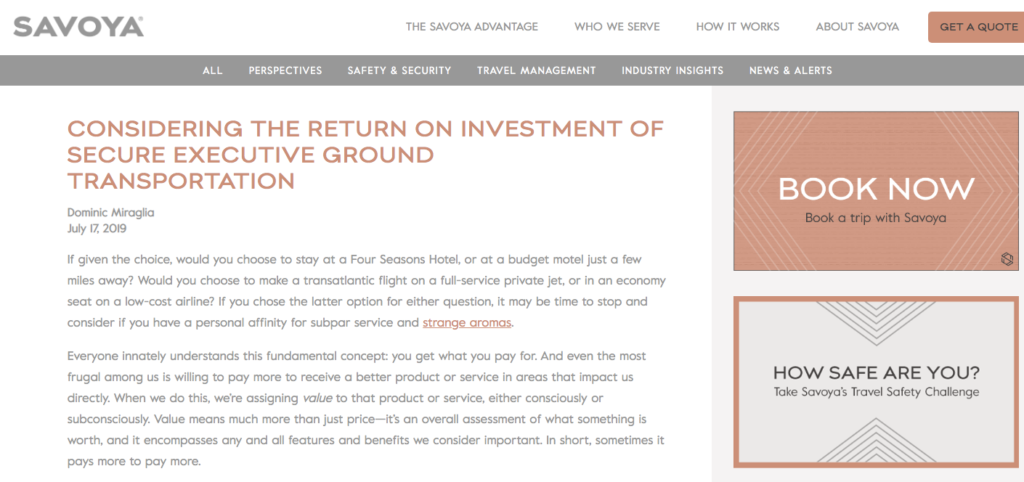
Understandably, executive ground transportation services are more expensive than taxis or services like Uber and Lyft. And given that the company likely faces the pricing objective on a regular basis, it’s used content pieces like this to contextualize the full value provided by the service in terms of the total ROI achieved by its customers.
You can do the same thing with sales reports. Check-in regularly with your sales team to learn what objections they’re facing most frequently. Look for opportunities to communicate your company’s responses through content, and you could take a huge amount of pressure off your salespeople by resolving the issues before conversations even begin.
Creating Content Around Customer Use Cases
Finally, use content to prove to customers that you can solve their problems by showing how you’ve done it in the past for similar clients. You may already be using gated case studies for this purpose, but don’t limit yourself to this single content type.
For instance, you could also leverage the power of use case content by:
- Inviting your top customers to contribute guest posts to your company’s blog
- Featuring them in webinars that walk through the issues they were facing and how your solution solved them
- Asking them to share a quick screen capture recording sharing what they like most about your product
- David Campbell, marketing lead at Right Inbox recommends isolating key quotes from your case studies and designing them into eye-catching social media graphics.
- Integrating use case elements into product or service description pages
- Developing a SlideShare presentation based on a customer’s story
As an example of that last strategy, check out Uniface’s case study for its customer, Synapse Innovation, which has been viewed on SlideShare more than 274,000 times:
Getting Sales Onboard with Content Marketing
As noted above, all of the content creativity in the world won’t have an impact on company performance if you can’t get sales fully onboard.
Test the strategies described above, but also test how you can best integrate your new initiative with your company’s salespeople. Do they respond best to email notifications of new content? Should you connect with them via Slack? Which content pieces seem to have the biggest impact on sales conversations, and why?
Expect that your process will evolve as you iterate based on feedback from sales and the numbers you’re seeing in your marketing analytics programs. With time, you’ll be able to adjust your content strategy and allocate your execution resources in order to properly support your sales team.
Do you take your sales team into consideration when planning your content strategy? Share any other tips or tricks you’ve learned in the comments below:
5 Ways to Build Links to SaaS Template Pages
If you are working on a SaaS (Software as a Service) website, then there are certain pages you want to target for links.
Either the page hits your bottom of the funnel (generate direct sales or leads), or it's part of your top of the funnel pages — to gain the interests and attention of your target audience without directly selling to them right away.
One type of page of SaaS sites that SEOs and link builders are having difficulty getting attention in terms of links are "template pages".

Insights On SaaS Template Pages
With template pages, it can be as helpful for your target audience — as it teaches people how this little tool solves a particular need (e.g. invoice templates for small business owners).
Your SaaS template page can also directly tied to your products, giving people a step by step guide on how to use the template along with the software your brand offers.
The second type of template is the most challenging. You often SaaS template pages attached to products - which makes it salesy.
If you've been building links for a while, you know sales pages don't get many links, as linkers find it uninformative for their target audiences.
In this post, we'll cover 5 ways to get backlinks to template pages of SaaS websites.
1. Learn from template-specific sites
It's no wonder to find it difficult building links to SaaS template pages.
But one of the key methods to discover if there are link opportunities for that specific type of page is to go look for template niche websites.
These are websites with template only content.
Take a look at this example:
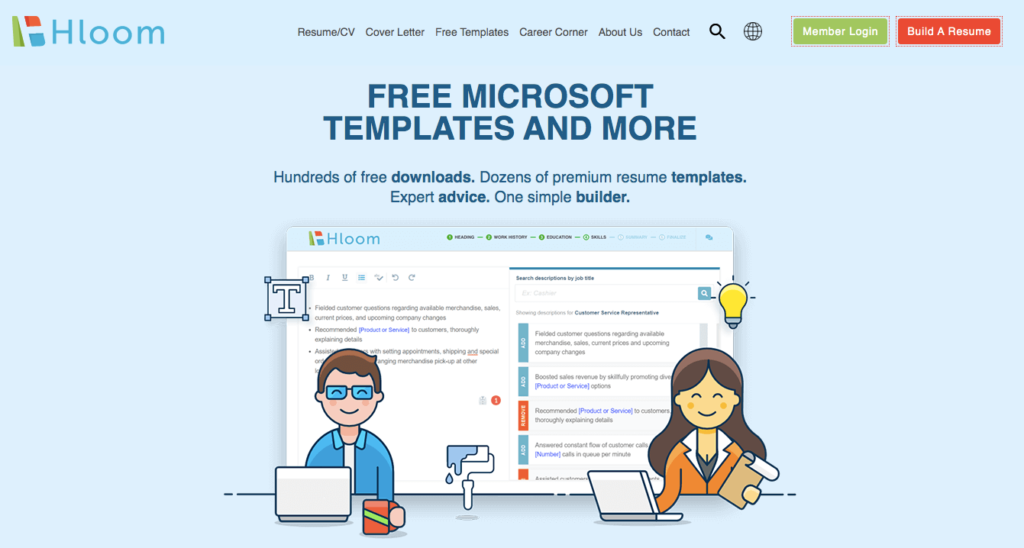
Hloom provides hundreds of Microsoft templates on the subject of career. They've been pushing high-value linkable templates that no one else in the market can publish.
What makes Hloom's templates linkable?
Their template pages are tied into other linkable content pieces.
The 100+ template content asset may not be highly linkable at the start, but accompanying it with other related linkable assets makes it easy for content consumers to see the template piece.
You can apply the same strategy to your SaaS template pages. Can you internally link to the page from other related more linkable content assets?
Sidenote: 5 Linkable Assets Examples (How to Create and How to Build Links to Them)
In our Hloom's example, resume templates page is tied to other related pages like, "How to Write a Resume", or "Resume Formats".
By adding internal links to your template page from other more visible pages, you're likely to get more eyeballs and potentially attract links to your main piece — your template SaaS page.
Another way to make your template asset increase its linkability is to add FAQ (Frequently Asked Questions) and even a section that shows how to use templates. In Hloom's case, there's a section on "How to Use Our Resume Templates".
2. Add citable elements to your SaaS template page
The hardest part of link building for SaaS websites is justifying the "citability" of your page. If it's too salesy, you're less likely to get links.
But that's not the case if you add citable elements.
What are these citable elements?
These citable elements are more informational and educational for a targeted audience. It's different from pure sales content, as it is more referential in its nature.
Here are some citable elements you can add to your SaaS template page (as mentioned by Garrett French):
- Data or “findings.”
- Direct quotation of a source.
- Defining jargon and industry terminology for the layperson (aka definitions).
- Pricing Guides or Generalized Pricing Information.
- Images, Videos, Widgets, Downloadables.
- Detailed, Multi-Faceted Metrics-Based Reviews.
- Tips/Advice Directly Related to Products/Services on the Page.
- The Origin Story.
- Supplemental Outbound Resource Links.
Apply it to the context of your industry and to what your target audience is looking at in terms of links.
You may find that by simply adding a "data" or "findings" will work wonders in gaining links to that page.
Double down on those efforts if it brings you maximum impact on links.
You can check out my guide on creating resource pages if you want to know more about linkable audiences.
3. Leverage resource page opportunities
When there's a justifiable reason for citing your SaaS template page, there is likely a certain type of link opportunity.
For template pages, the most common type of linkers is resource curators.
In our Hloom example earlier, you'll see bunches of resource curators - seniors, students, parents of teenagers, and people with disabilities looking for job opportunities.
Fortunately, the template piece serves many resource curators audiences. That may not be the case for your SaaS website, what you can do then is to tie it to or add a citable section to your template page that may well serve any of the linkable markets below:
4. Build landing page links with brand mention outreach
Depending on how huge your SaaS website is, you'll manage to find a lot of unlinked mentions of your brand, most of which will come from pages citing or referencing your tech products.
Most of those brand mentions are primarily for your homepage.
That's okay. But you want to get more specific links — more relevant links, if you may.
You can ask publishers who've mentioned to direct to your SaaS template page — you may see at times that these publishers are receptive to your link requests.
Instead of them giving links to your SaaS homepage, they could link to a more relevant page — SaaS template or your product page.
There are many tools to help you out with the brand mention tracking process — one, in particular, is BrandMentions by Razvan Gavrilas.
Here are more resources on brand mention tracking:
5. Tap off-site brand content like blogs
Take the "restaurant website template" as an example.
It's not a solid linkable piece if you ask me. But there are ways you can go address the needs of business owners, which makes the content more compelling for linkers.
You can search for blogs and look at any topics that might seem more relevant for entrepreneurs. Topics like smb management, digital marketing, or customer relationship management.
You can apply the same method to your brand context.
Check any bloggers and other publishers in your industry that post about "things to consider" or "how-to" articles where the topic of your SaaS template page may contextually fit, at its best.
By doing some research on maximizing "offsite brand content strategy", you'll find ways to penetrate bloggers in your space.
Make Your SaaS Template Pages Link-Worthy
If you're a SaaS founder, marketer, or SEO, you know this part is difficult to execute. But there are methodologies and actionable tips you may find useful in this post. Apply it to your own context and let us know in the comment section below your experiences, so far.
How to Use Webinars For Link Building and Lead Generation
Webinars are all over the place. From left to right, we see entities, businesses, and individuals using webinars to promote their own messages to people — whether for the purpose of educating their audience or selling them products or services.
What makes webinars so useful is its built-in value where knowledgeable experts share their insights on a given topic. The value of content increases even more as the expertise to skills becomes more relevant and more useful to the audience.
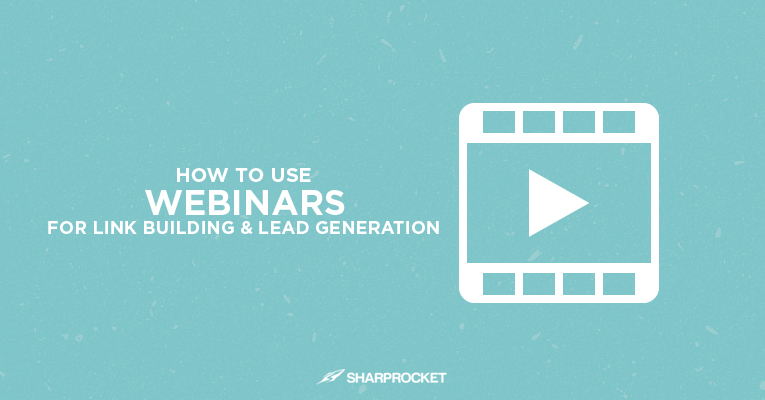
There are different formats of webinars, most of which come with a full seminar-like discussion on a subject matter. Others prefer to have an interview or Q&A type discussion with esteemed guests.
This now gives us a full reason to maximize webinars for the purpose we're engaged in.
In this post, we'll cover how you can use webinars for link building and lead generation.
How to Use Webinars For Link Building
Content is king - no doubt. If you don't have content to offer to potential linkers, you're less likely to get links. Even if you have established thought leadership and authority in your space, you still need to produce content pieces to attract high-quality backlinks.
Webinars help you pursue link building. You only need to be strategic in how you develop this content piece and distribute it massively to your target audience.
Guest on topical webinar series
First in the list of link building techniques is reaching out to content developers with webinar series. These webinar series feature guests in the industry who can be part of the discussion — either as a webinar lecturer or guest interviewee.
Take advantage of this opportunity given that you can hit two birds with one stone — get links from webinar transcripts (once the content is published on the creator's blog) and increase brand awareness for your site.
Take a look at this webinar series by Search Engine Journal.
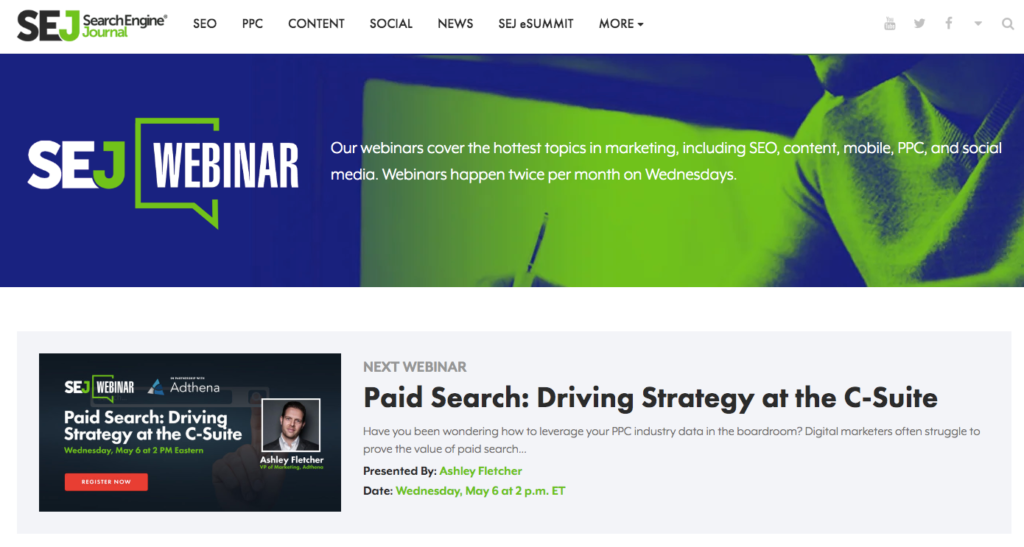
Start by searching for links of webinar series creators in your space.
You can use Google search using search phrases, like "webinar series" "INDUSTRY" or "webinars" "INDUSTRY".
Create a spreadsheet to fill in details of your target webinar creators. These include website name, the title of webinar series, host, and contact information. This helps you easily track the progress of your outreach once you begin with sending email pitches.
When doing outreach to webinar content creators, use your expertise, and describe how it can be of help to their audience. This is your value proposition — at its best. Maintain the conversation with your intent of providing more value to their followers than just appearing to be going only after for links.
Distribute webinars as guest posts
Another way to maximize webinars for link building is through the distribution of webinars as guest posts.
Essentially, you don't simply send links of your webinar videos to your target prospects. You check first with target guest blogs what they want as topics for their audience.
This is where you should play creatively. You can use the topic of the webinar as one of your suggested guest blogging ideas.
In addition, you may also chop a webinar into different topics (if the content is full-packed with information) and suggest these topics to your prospective publication.
You can check out this detailed guide on scaling guest posting ideas.
You can transcribe your webinars and turn them into actual guest posts (with edits on the side).
Another means is to only get insights and points of your webinars, use them as your outline, and write a guest post from scratch.
Both ways can help you craft a high-caliber guest post for your target blog.
Turn webinar slides into infographics
You want to maximize every piece of production for a webinar. That includes the slide presentation used for the discussion.

You can turn webinar slides into some kind of infographics, particularly if the points or information are easily digestible in an infographic format.
By outsourcing graphic works to a freelancer, you can automate this process of turning webinar slides into infographics. This makes more ROI positive if you are doing webinars regularly whether for internal or external production channels, as you get more infographics produced from many webinar slides.
Besides for link building purposes, webinars are also utilized to generate leads for a business.
Let's discuss how you can use webinars for lead generation.
How to Use Webinars For Lead Generation
As I've mentioned earlier, webinars have built-in value if it's presented by thought leaders in the industry. That makes it easy for content teams to get visitors to flow through the marketing funnel — potentially hitting the bottom line of new customers.
One high utility of webinars is making it as a bait for visitors to collect their email addresses in exchange for the video content.
Landing Pages
Create a dedicated landing page that emphasizes what your content consumers can get out of your webinars. Ensure you'll have forms to capture their email addresses. Example of which is this webinar landing page by Wordstream.
Short Videos
In the age of distractions, people tend to lose their attention quickly on long video messages. That being said, putting a webinar for them might require that your content is of high value in order to retain their attention.
The best way to capture more interests and make your brand gain more visibility is to chop webinars into short videos. These are videos that can stand on their own and can be disseminated quickly depending on how good your short video is.
What you want to do is to edit short videos in such a way that it highlights the value of information without losing much interest from its prospect watchers.
So, how do these short videos play in generating leads?
As you get more eyeballs to your micro content, you generate awareness of your brand, hitting two sections of the funnel — Attention, and Interest.
Podcasts
Podcast consumption has increased dramatically for years now. Taking advantage of this opportunity can help your business improve its lead generation activity by numbers.
Format webinars into audio content. Start a podcast featuring these new content pieces from your webinars. Repackage it such in a way that it keeps listeners engaged.
Key Takeaways
Don't just ride on the current trends in marketing where everyone is into webinars. Remember to have a good strategy and set of action plans to be able to maximize what you have produced in order to build more relevant links — and eventually, generate leads for your business.
Give consideration to how you distribute webinars to your target audience as this will help increase visibility and likelihood of your campaign success both for short term and long term goals.
How to Work Remotely With Link Building Teams
Given the Covid-19 Coronavirus crisis, many companies face new challenges in transitioning to a new work environment. While remote work setup is being practiced by many brands in outsourcing industries, a lot of adjustments still have to be made.
Working remotely is a new skill.
More particularly, if you are working with a team, it takes a little while before your team can transition smoothly to an efficient and effective system of remote work.
There are a couple of guides available to get you started with remote work. Here are some useful resources that you would find to be useful:
- A Complete Guide to Turn You Into a Pro by Paymo
- Answers to Remote-Working Challenges
- Remote Work Guides and Tips by Aleyda Solis
As a link building agency, we've transitioned to full remote work setup weeks ago (as of this writing). This brings us lessons from experiences ourselves and from observations on other SEO agencies and link building teams.

On Working Remotely
You can't have the full same format of work in office applied to work from home setup. These two are different.

For instance, communication should be more prompter than usual, as the only way to get things done is through faster feedback on tasks. Another is of usage of some software for work. Cloud-based types of software must be more often than not, be used by teams to organize projects and to designate tasks properly to members.
How to Work Remotely With Link Building Teams
This is not a comprehensive guide for working with remote teams. But rather, focus specifically on link building activities, and tips on working with link building teams to achieve link goals for clients.
1. Create performance reporting documents
In many brands, they call it as key performance metrics KPI reporting sheet or document. For content teams, that may be the number of content assets produced during a set period of time. For us, link building teams, the range number of editorial links delivered to our clients for their target pages.
It's essential to have one for your link building team. First, you get them accountable to monitor their own performance at work. Second, you measure their productivity based on the highest impact and highest flexibility of tasks they do on a daily work basis.
Have a performance reporting document set up for your team. You can get a manager to monitor and have documents ready for you or you can do it yourself.
2. Plan out your teams' daily or weekly schedules
Once you know your key performance indicators (for some, this has been identified before even transitioning to remote work), start planning your team's work schedules.
Not everyone will have the same work schedules, depending on the volume of work you have as an agency. Some teams may be skeletal, which means they get to work through batches. Batches of teams may work earlier during the week (Monday to Wednesday), while others get through the Wednesday to Friday work schedule.
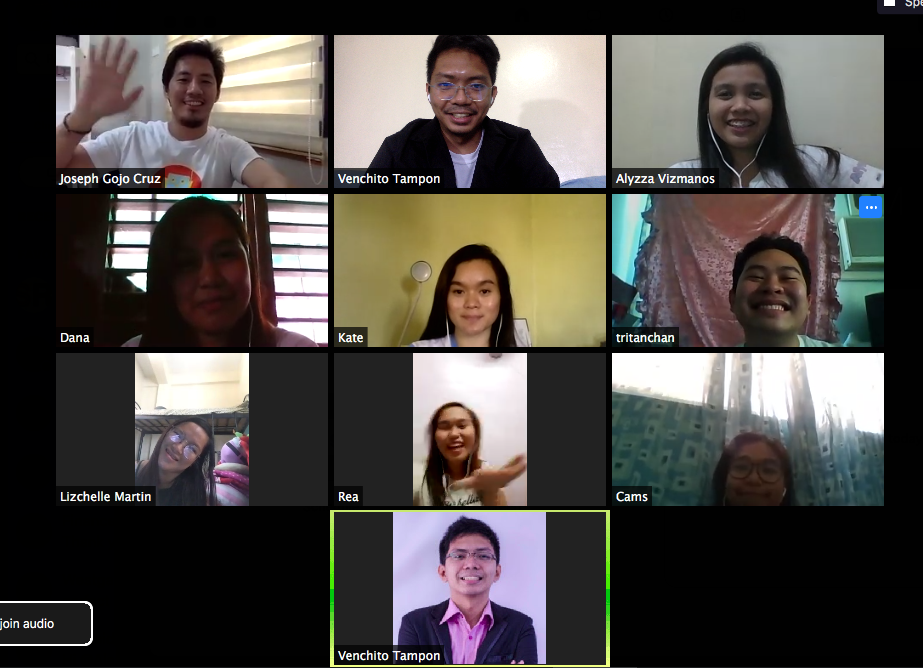
Through planning, you'll see methodologies for better work efficiencies and productivity.
Here are some tools you can use to manage work schedules and to delegate tasks effectively:
3. Conduct daily or weekly meetings
While you can't conduct in-person meetings with your team members (as what you do in-house), you can still effectively conduct online meetings with your subordinates.
Essentially, what you should be looking at here is proper schedules of 1-on-1 and team meetings without members sacrificing their time for prioritized projects and tasks.
Here are some tools that you can use to communicate and/or scheduled meetings with your team:
In communication, it's important to tell your team how and when they can reach you. There are urgent matters that have to be addressed properly, so giving your team your free schedules for interruptions help in addressing important matters quickly and thus, achieving target goals.
4. Address challenges and problems by providing solutions
There are minor and even intricacies when working with remote teams — that's not a surprise anymore. Weekly meetings with your teams and proper lookup of their current output give rise to many problems of inefficiencies and unproductivity.
You don't have to address them all at once. Identify problems that contribute negative impact on working performance and team culture. Provide solutions by asking your team for suggestions, as well as getting coaching and mentorships from other agency owners.
Here is a good webinar recently by Dev Basu of Powered by Search that addresses some challenges agencies face during a crisis:
Once you've identified challenges, the next step is to find any points of improvement.
These improvements can be implemented one by one. Then see which of them makes a significant impact to work productivity based on their expected changes in outcome.
5. Never forget training of your team members
This shouldn't be the last tip in this list of remote work recommendations. Training is ongoing essentials of an organization.
Without it, you expect plateau in growth, and could greatly affect your business' bottomline — if you're the agency owner.
Start with creating your training documents for your teams. It is best to have it available before work from home transitions. But regardless, you can spend some hours on top of your current daily work priorities to prepare them.
You can use Google Drive, Asana, Basecamp, Trello, Camtasia or Loom (for video recording) to prepare team training.
Here are some further tips to manage and develop your remote teams:
- Build morale of your team through pre-meeting conversations. Giving them encouragement and needed help to support non-work and work-related concerns.
- Get coached by agency owners who have extensive experience handling remote teams. This gives you new perspectives on things to adapt and apply to work from home functions.
- Address immediate employment concerns. Have it effectively conducted by your HR and admin team members, so you can focus on your priorities.
Further Reading:
Remote Work Made Simpler
I didn't say remote work made easy. Because it's not. However, by applying tips I've shared above, you'll be able to see increments of improvements to your remote team's productivity and work performance.
How to Create Brand Awareness Through Link Building
Brand building is the new link building.
Communicating your brand in a way that captures the attention of its target audience through quality content and community engagement.
You resist shortcuts and spammy link building tactics and focus more on thinking how your links can affect your brand value and brand equity.
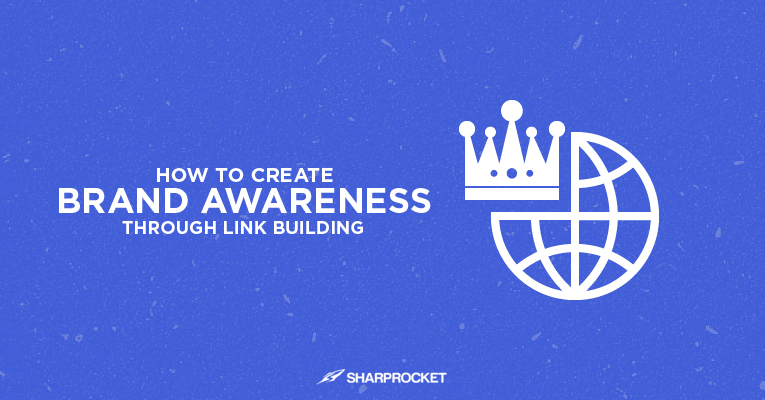
What is Brand Awareness?
Brand awareness is the extent to which consumers are familiar with the distinctive qualities or image of a particular brand of goods or services.
Strategic link acquisition starts with identifying your brand's distinctive qualities.
On unique value proposition
A unique value proposition plays an important role in how you deliver your content assets to its intended audience.
If you can discover what your brand differs from its competitors — may it be in the total brand scheme or purely for content sake, you can easily emphasize the uniqueness of your brand or your content in all of your external marketing efforts.
Given that potential linkers receive endless pitches from brands looking to get natural links from people's blogs, linkers become more aware of what makes content on a particular topic unique and valuable.
They've seen different formats and styles of content for a particular topic. They knew what makes content different from others.
When you know your content's value proposition, it would be simple for you to create brand awareness around it. As you know how to position it to people who are likely interested in sharing and linking it, as well as improve the entire content asset for better information and value.
Importance of Brand Awareness
Fosters trust
You don't participate in any engagement of a brand if you don't trust them at all.
The same is true in pursuing links through brand awareness.
When people become more aware of the caliber of your content and what your brand stands for, as far as disseminating information is a concern, you gain trust from publishers and other content creators in your space.
Positioning yourself in the market
Getting a market share in an industry, particularly if your brand is just starting out, is never easy.
There has to be a strategic approach in building the authority and positioning yourself in the market.
Link building helps your brand gain momentum, wherein organic links become easier as people are starting to recognize your content every now and then. They link to your content pieces naturally as you develop your expertise in the market. Brand awareness does that.
Develops association
In building awareness, you gain new contacts and networks you never knew in the first place.
These are brands and individuals who gained a good understanding of your brand.
The more you build brand awareness, the more you become associated with influential people in your space — which primarily helps in gaining more exposure and secondary benefits of backlinks, social shares, and brand mentions.
Resulting to brand loyalty
The law of momentum starts to kick in. As you create awareness around your brand, you earn interest from people through the quality of your products and through the value-adding information of your content marketing efforts.
When this happens, you position yourself in the market and attract customers who will repeatedly buy into what your brand offers. This results in building new sets of brand advocates — resulting now to brand loyalty.
How to Create Brand Awareness Through Link Building
1. Strengthen your brand ambassadors
People connect to individuals more than brands. Brands don't have personalities unless a person or group of people from an organization speaks up — these are brand ambassadors.
In the idea of link building, brand ambassadors are people of a brand with a high level of expertise on topics they care about.
These are people who can go out and contribute something of value to the web community — may that be in a form of content, quality conversations on niche forums and community sites, and other initiatives that engages value.
Here are some brand ambassadors you can gain inspiration from:
Tim Soulo, Ahrefs - SEO Saas

Do you have to force your CEOs or founders to be brand ambassadors?
Definitely not. There are options you can choose:
- Opt to hire a thought leader in your space who can go on behalf of your brand — this could be an industry follower with existing huge following or someone starting out in the field but has extensive work experience.
- Start looking for someone who can build credibility through content contribution internally and externally of your brand assets (e.g. blog publications). It could be you or it is someone else.
Either you choose to hire an experienced influencer or build credibility for a potential brand ambassador. You need to strengthen him or her for more effective link building results.
How to build links by strengthening your brand ambassadors:
- Use expertise to build links. Learn how to use HARO and subscribe to the platform. Choose topics your brand ambassador has expertise in. Then deliver at best by answering questions with direct answers.
- If the brand ambassador is starting out, build his or her portfolio by contributing to mid-tier publishing websites, then go all the way up to niche high-end content publications
- Develop associations by engaging with past networks of friends with an online presence. Start sending emails or sharing their content on your social profiles to send radars on their signals that you're into the same line of industry.
2. Organize or sponsor an event
Events are a great way to elevate your brand.
Organize a public event. Either you do it for your brand alone or hire subject experts in your space to speak about topics they care about. Align topics into one theme and start an event.
Glen Dimaandal, a local and international SEO speaker produced several events on his own — PeepCon and SearchWorks which have become locally known for bringing experts in the search marketing and digital marketing field.

How to build links by organizing or sponsoring events:
- Set a name for your public events to get brand recall — for your participants to quickly remember when they see your events on different web places.
- Get authority links from event syndication and distribution websites. All it needs are your event details.
- Incentivize bloggers and content creators who are participants of your events. This is to get natural event reviews and/or mentions on their blogs — when this primarily depends on the quality output of your event.
3. Maximize podcast opportunities
Podcasting is mainstream nowadays.
Any content creator in industries that I know is thinking of ways to penetrate podcasts: either to start their own podcast or become a guest.
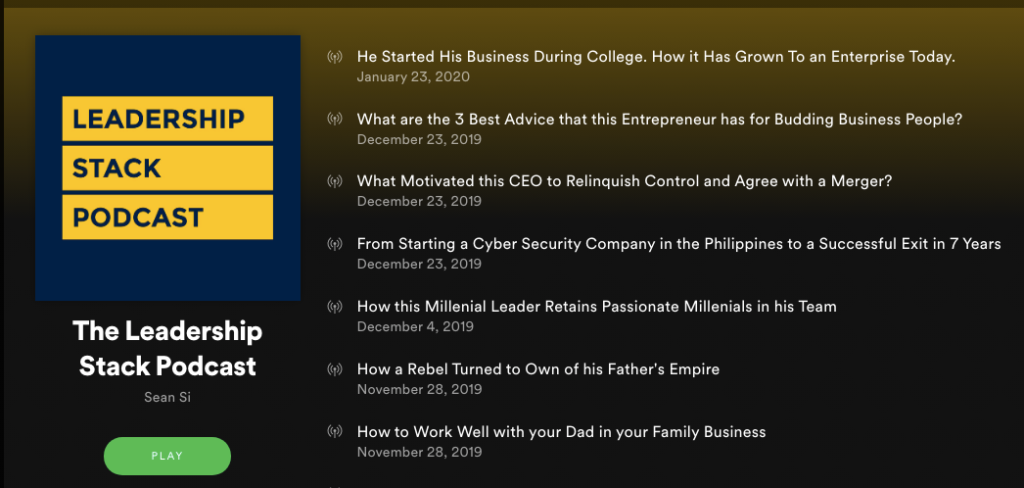
If you're trying to gain exposure by being guests on podcast shows, you can start reaching out to relevant podcasters.
I've covered the entire process of how to get podcasting link opportunities. But here are a few tips from the guide:
- Prospect for blogs hosting podcasts through discovery in iTunes search, Google search, and podcast directories.
- Organize your list with host/s name, contact details, and description of podcasts for easy customization of outreach emails.
- Choose a podcast show to pitch. Ask some assessment questions: Is this podcast providing external links to websites of guests on podcasts' footnotes or transcripts? Is the show focuses on discussing narrow or broad subject matters — is it a fitting topic to our brand? Is there a substantial number of followers on social and networks that can help us create more brand awareness after podcast guests?
- Pitch to become an interview guest. Share your portfolio and details on why you deserve a slot. Don't be too aggressive in followup emails. Here is a great post on how to send a follow-up email after no response.
Once you receive links to podcast interviews, start sharing it on your social profiles and to your email subscribers — to get a ripple effect of bringing in a new audience to podcaster's following list, while at the same, create awareness about your brand.
4. Create tools for targeted audiences
Content that creates both interactive and learning experiences gets the most editorial links, in most cases.
Tools are an example of this type of content. It helps audiences to do or to learn something specific.
A few examples of tools that work are:
- email signature generators
- privacy policy generators
- SaaS metric calculators
- blog idea generators
- invoice generators
- SEO checkers
There are so many other examples. Think of ideas by discovering problems no one in your industry has solved yet, or if there is one solution that has some features not catering to solving those problems you've discovered — you can take advantage of that.
How to build links to helpful tools:
- Start including descriptive links in your external content (e.g. guest posts) that previews your tool, if it's relevant to your post.
- Create short videos or how-to blog posts that showcase your tool. You can use Loom or Camtasia for video recording.
- Invest in community engagement by sharing a link to your tool page. You can exclusively give influencers in your industry early access to your tools. Exclusivity offers an advantage for more link opportunities.
5. Leverage influencer outreach
Start by reading why and how influencer outreach works in this guide.
Identify influencers who be will your key people of prospects for more brand awareness through link building.
How to make the most out of influencer marketing:
- Strengthen relationships with influencers, even if there are no opportunities for links. Don't let "for just links" mindset get in your head every time you connect with influencers. Adapt the "law of reciprocity" by offering too much value to a person that it helps you get residual benefits in return.
- Look for upcoming influencers as they are most receptive to press and interview requests, even product reviews.
- Categorize influencers as micro and nano influencers — you can check out this guide on how to do it.
- Collaborate content with thought leader content creators. You get the benefit of association once you do that.
- Interview influencers on your media channels (Youtube or podcast sessions). Once they share it with their networks, you create more exposure to your brand.
Think Brand Building
Think of branding when doing link building.
Always go for long-term benefits and initiate massively for building your brand. Through brand awareness, you start positioning yourself (your brand) in a way that you earn trust, respect, and tangible benefits, such as links and social shares.
Applied Attraction Marketing to Link Building
Without content, it's tough to build links.
Content ties the interest of the linker and your brand.
The content that has the highest value proposition to the end-user proves to get the right types of links.
Well, you can use content in two ways.
Reach out to a potential linker and offer your content as your value proposition. Your content matches the needs of their blog audience and in return you get a link. Success.
Or, create content that attracts links over time. Manual outreach is part of it, but because the content consistently attracts potential linkers, link building becomes almost automated.

Attraction Marketing
We'll focus on the second — attraction marketing.
Attraction marketing is the process of drawing interest to a company, product or service using carefully devised techniques. The goal is to attract potential customers to the way the item has bettered the seller's own life.
When you focus your efforts on executing a strategy that attracts link opportunities for you, you get the most leverage.
While you can't choose which page links to you naturally, you can expect a consistent link growth for your pages with a link-attracted content strategy.
On Building Assets That Attract Links
Content assets must have its intended purpose. Creating content assets for the sake of fulfilling your editorial calendar is useless.
There is economics in a content-based link building environment we all have to consider. Links, as the main primary goal for an informational page, can have a secondary effect and value to the bottom line surface of the brand.
The right types of links will get your content to increase its search visibility for target keywords by making it rank better. But an additional secondary value to that is if those links can push further the secondary effects to the brand.
Attraction-driven links have high relevance standpoint
The right type of content attracts the right type of links.
When you compare links driven through manual outreach and links naturally acquired through ranking content for search, you can see different patterns of decisions.
For example, in manual outreach links, you can decide what websites or blogs to do outreach to.
From a relevance standpoint, if a team of link builders doesn't understand the relevance of links at its core, you run the risk of getting not-so topically relevant backlinks for your webpages.
Links attracted in any form have a higher assurance for relevance particularly from publishers who perceive your content worthy of reference. Content creators can be assumed to link only to sites and pages that are relevant to the information they're creating content about.
In general, links with more attraction marketing intent can have relevant links acquired that fit three important link factors: relevance, trust, and authority.
Links attracted push referral growth
Relevant links are likely to get clicks from its referring pages especially if those links drive click intent, such in the case for referential links. It gives an additional desire for the reader to look for more information.
If a content asset that ranks for search gets referential links from publishers, there is a likelihood of referral growth.
Given that those referential links can drive referral visits to their referring pages (your pages), you increase the odds of more content creators in your industry vying for more references. Chances are you multiply referral visits to your content pieces when you get more of this type of link.
Links attracted increases content's search visibility
With an initial solid manual outreach to get links to content, that page can rank for its target keyphrase. If keyphrase is referential in nature, when it ranks, it attracts more eyeballs from publishers who consistently discover updated and latest pages to cite on their own content works.
Attracted links can be turned into meaningful relationships
The law of reciprocity states a mutual exchange of value.
When you've been given a link by a publisher, there is an inherent desire to give something in return. While it may not necessarily be a backlink as well, you could perhaps send an email message with a thank you note in it.
Given that those recipients are actually the ones who link to in the first place, there is a built-in connection to respond to your email.
A subtle message for people who naturally link to your brand can lead to meaningful relationships, which then leads to more in-content links in the future.
Attraction Marketing Applied to Linkable Content Creation
When you build content pieces for link attraction, you think an end-to-end process.
From topic research to content's organic link acquisition activity, you ensure every step is tied into every other step.
A well-thought initiative for topic research, for example, should perceive the right audience for outreach, when it's content promotion time.
Every activity in the way must be well coordinated to ensure a much larger success in the campaign's end results.
A. Find referential topics or source-to-cite queries
Content strategy starts with ideation or getting blog post ideas.
Generating content topics for a specific purpose is vital to the success of the content marketing campaign.
For an attraction marketing-driven campaign, you want to find topics that have a chance to earn links from publishers.
These are normally referential topics or source-to-cite queries.
Content creators refer to valuable pages by citing them on their blogs.
Before diving into topic research, it's important to understand why people are actually searching for (even linking to certain pages) for additional references.
1. The difficulty of defining, describing, and explaining the topic
Is there a demand for the keyphrase to come back again for another time and search for that same keyphrase again?
Think about it. If a content creator wants to know what this jargon means because it's difficult to explain it in layman’s term and may require definition from a credible author, it has a chance to be included in another content piece by directly linking to the source page.
This is an initiative of content linking to the definition of a technical term as it gives the entire overview of what the phrase means.
While you might be aggressive about this and try to create your own definition of every technical term and publish them on your site, it's important to understand the difficulty as well as the demand for the keyphrase.
Other examples are concepts that can't be published by non-practitioners. Any new industry concepts require technical expertise to explain it clearly to its intended users.
IIf your brand can simplify a concept to be better consumed by its target audience, this makes the topic feasible to attract potential link opportunities from publishers.
2. Ease or convenience
For basic applications that demand more attention and time to create is an opportunity for content creators diving in the attraction marketing idea.
Here are some examples of the type of content that aids people to create content for personal purposes:
Rental Income Expenses Template (SPREADSHEETS)
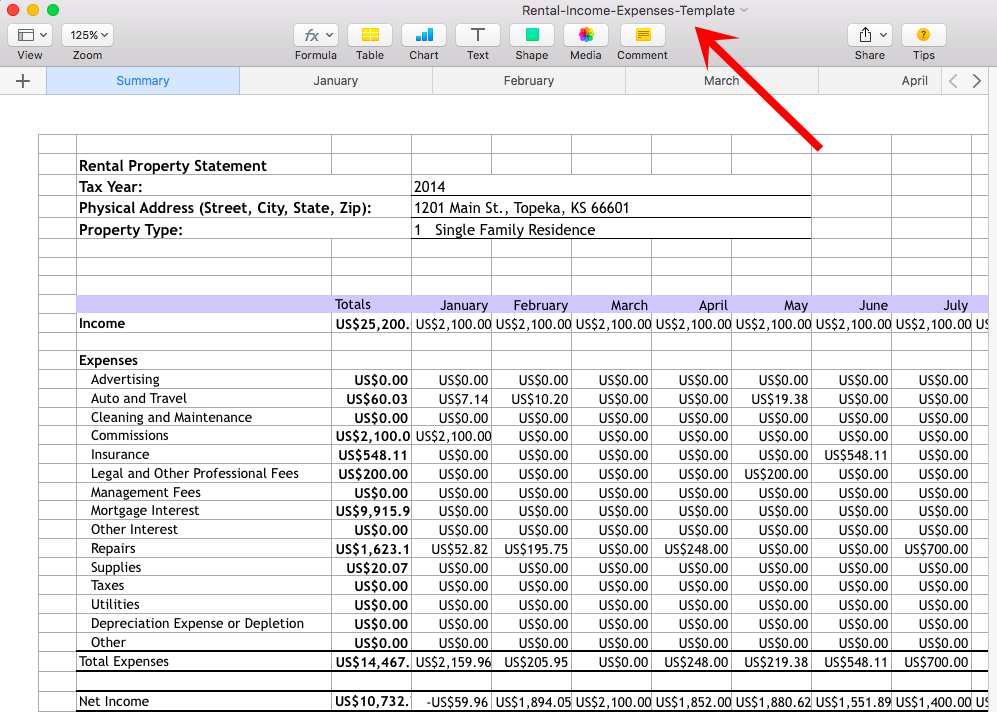
MBA Recommendation Template (RECOMMENDATIONS)
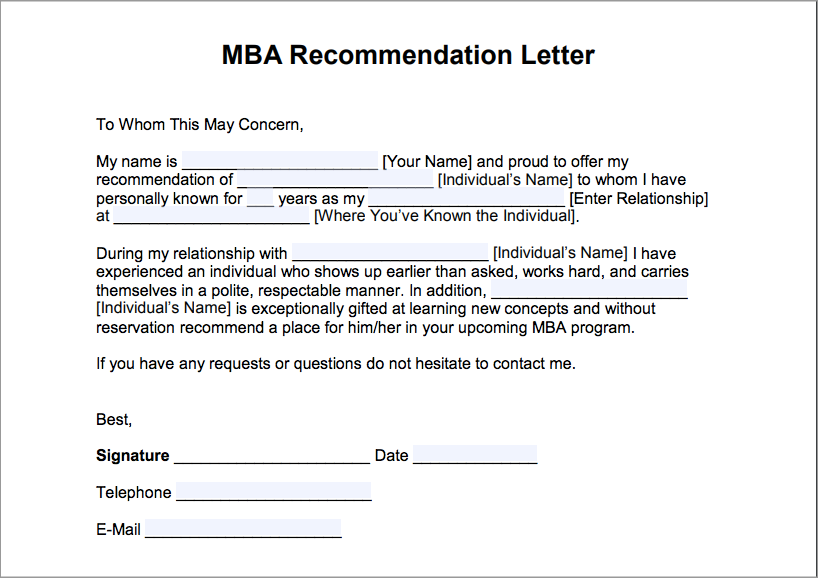
Other types of templates:
- letter template
- estimate template
- proposal template
Most of this type of content would be more useful if they can be customized immediately. PDF forms uploaded to websites require more friction as it needs to be converted to an editable file format.
Regardless, sample content pieces with editable sections are topics to consider for an attraction-driven linkable content.
3. Additional credibility for content
Referencing valid external sources increases the credibility of the content.
Topics of a survey, data, numbers, and statistics have high possibilities of linking as they are deemed necessary to make a content piece updated, relatable, and credible.
Finding Source-to-Cite Queries
Look for any queries that fulfill the aforementioned needs:
- the difficulty of defining, describing, or explaining a topic
- ease or convenience
- additional credibility for the content
Discover any of these source-to-cite queries in your industry:
- statistics
- data
- template
- letter
- sample

It is best to look at the current linking patterns of the top-ranking pages for your preferred queries. Here are things you have to consider:
- The average number of unique referring domains of currently ranking pages for the query
- Type of links (citable, branded, etc..)
- Link placement
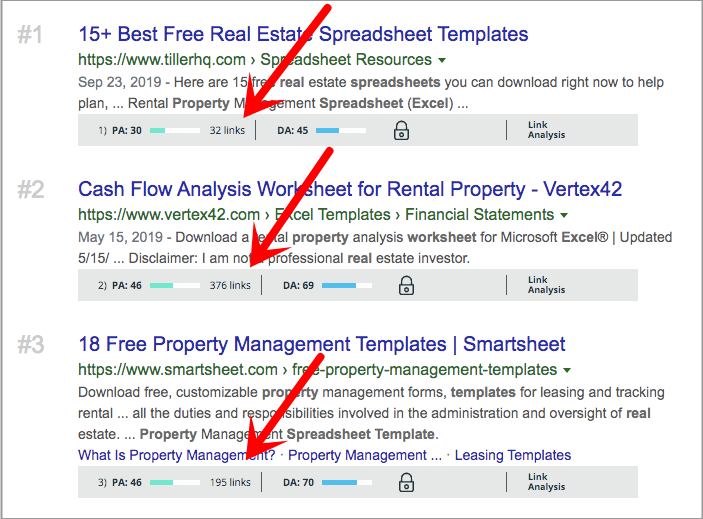
By having those considerations, you can then estimate a good number of links to expect when the content ranks for the query.
B. Use manual outreach to acquire initial links to rank for those queries
The competition of the search for the key phrase matters whether you can easily rank for it or not.
If it happens that the keyword difficulty is too high and the ranking pages have more than 50 or 100 links attached to them individually, it will require a massive outreach campaign to even get the page 2 or 3 ranking spot. That's the reason why it's important to study the topic of competition. The question you need to ask, "does my site have enough authority for my new page to rank for the query?"
That being said, investing your efforts into initial manual outreach is needed to get the initial backlinks to rank for source-to-cite queries.
From the Future agency recently launch a useful tool that can semi-automate the promotion process of a content piece.
It solves that one overlooked simple strategy in content promotion — which is basically reaching out to all brands, sites, and publishers you've mentioned on your page.
Given that, if you can reach out to these mentioned content creators, there is a reciprocal benefit you can gain in terms of a link, mention, or social share of your content piece.

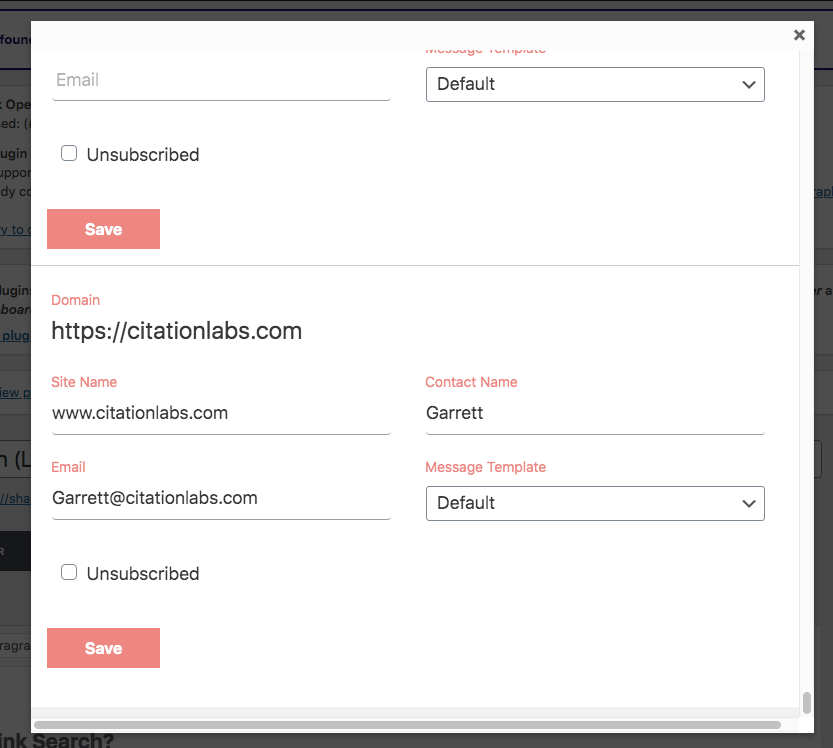
You can also reach out to publishers who've linked to content assets similar to yours. Discover those linking pages using Ahrefs in two ways:
- Use Backlink Explorer to find all pages linking to a similar content
- Use Content Explorer to find highly related pages and discover links to them
The leverage to push the content to dominate the first spots for a source-to-cite query is certainly difficult.
Your results depend on the quality of your content and the relevance of your link prospects to your page.
The moment the page dominates the top spots for the query, you can expect links from people who've used your content as a reference to their online works. The more links you get from this almost automate the process of link acquisition, the higher it'll climb to the top of the search.
C. Use optional paid advertising to build more momentum
Another way to build up the content higher in rankings is to spend a minimal amount of money on advertising (~$100).
There are two advertising options you can use: pay-per-click and Quora.
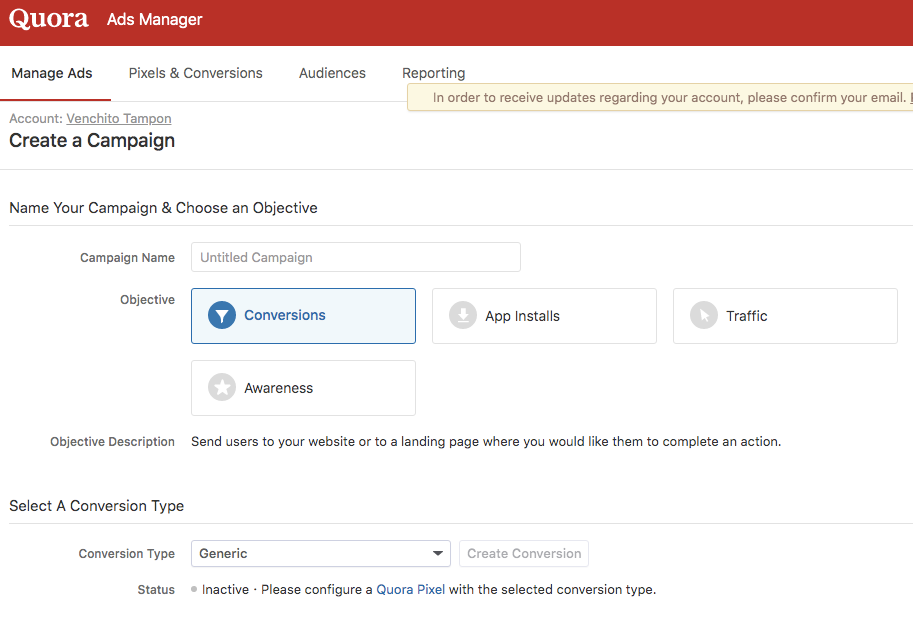
Depending on the cost per click for the query (for PPC) and the number of possible visits from Quora, you put more eyeballs to your web asset, which then leads to an increase in search visibility for the query.
Google paid advertising also gives you the leverage to first be seen when people search for the query. This means they have more chances of consuming and eventually including in their publishing initiatives.
D. Use Aware or Ahrefs to monitor links and mentions
Use tracking tools to monitor any new links to your source-to-cite content piece. By doing so, you can check the advertising spent or the return on efforts you gain from doing the initial manual outreach.
There are secondary effects you might miss out if you focus alone on bare link metrics. Try to monitor or at least look at the next set of links after you rank for the query as well as the relationships you've built or might have built during the process of content promotion.
Build Momentum in Attraction Marketing
One attraction marketing method is to let people come to you because they've known your brand.
While that's easy to say, it's not a reality for many brands online. Some of them must build the initial momentum to get the initial visibility in order to attract people they expect to have for their website - whether those are link opportunities or branding and relationship networks that can scale the online business.
Whatever it is, build momentum first, then leverage on what words for content promotion, and start seeing results from both branding and link perspectives.


